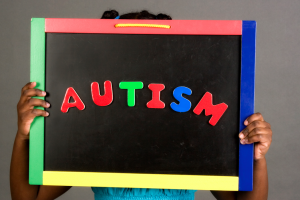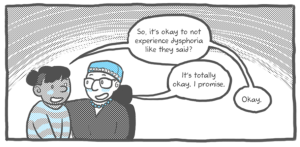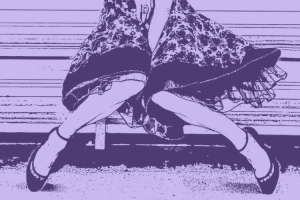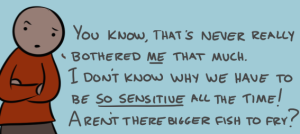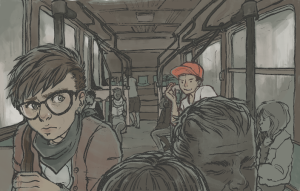Have you ever experienced someone insulting you in a way that felt a little bit racist, but you couldn’t quite figure out why?
Were you worried about “reading too much into it,” “being too sensitive,” or taking offense when none was intended?
When this happened, did you let the other person know you were hurt, only for them to become distressed or defensive? Have you been reluctant to say something when you felt this way because your opinions have been silenced or ignored in the past?
Like many other people of color (POC) living the US, I’ve felt all of these things. For some of us, feeling this way is the norm and, without realizing, we put up a wall to protect ourselves from the damage that comes with it.
These uneasy, uncertain feelings can be the result of what Chester M. Pierce, a psychiatrist and professor, coined racial microaggressions – originally defined as the racist insults directed at Black people from non-Black Americans.
Dr. Derald Wing Sue, who also writes about racial microaggressions, explains them as the “brief and commonplace daily verbal, behavioral, or environmental indignities, whether intentional or unintentional, that communicate hostile, derogatory, or negative racial slights and insults toward people of color.”
Microaggressions are “micro” because they often happen in small, private situations, yet their effects often impact us in massive and dangerous ways.
Over time, being on the receiving end of these everyday (yet often unrecognizable) attacks can lead to depression, social isolation, and lowered confidence. Because we’ve been conditioned to question ourselves and not the perpetrators or the situations, we begin to wonder if our own feelings and experiences are legitimate.
Sometimes, without understanding what we’re doing, we even internalize those aggressions and use them to police both our loved ones and ourselves.
As a kid, I often corrected my mother’s pronunciation of English words. Though she did have a Chinese accent, she didn’t need me to tell her how to speak English – she’d taught English as a second language for more than a decade.
I didn’t realize that by doing that, I was communicating that her foreign accent not only made her English different, it made it wrong. And like so many others, I had no idea I was regurgitating racist ideology (practicing internalized racism).
While small acts of internalized racism like mine go unnoticed all the time, there are too many occasions where the victim is just too shocked to say anything in the moment.
Whatever the reason, it amounts to letting racism off the hook. When we allow these small incidences to keep happening, we are allowing racism, in general, to remain a part of our culture.
As Dr. Sue goes on to state, the perpetrators of microaggressions are often unaware of how they may be offending or hurting others.
It’s important for us to remember that just because a perpetrator of racism is clueless (or in denial) about the impact of their words doesn’t mean that their actions were any less violent or that the impact of that violence is changed.
When it comes down to it, intention is irrelevant.
If we only focus on intention, we continue to center and prioritize the perpetrator. And let’s face it: The perpetrator is always a more privileged person who is used to getting their opinions and feelings validated.
We are trained to believe people with social power.
But if ever we hope to truly put an end to racism (or any other injustice for that matter), we, as people who encounter so much marginalization, must also validate our own feelings and opinions. We re-center our attention to our needs and experiences by focusing on impact, not intent.
By not reacting to microaggressions, we can lose our sense of being true to ourselves. We risk bottling up the toxic feelings brought on by unending racism. But if we react angrily, we are often faced with defensiveness and criticism from our perpetrators.
But, alas, there is a middle ground, and that is to engage the perpetrator in a thoughtful manner. Vlogger Jay Smooth has a great video about it here.
The Three Types of Microaggressions
Dr. Sue and others at Teachers College of Columbia University have identified three basic forms of microaggressions:
1. Microassaults
Microassaults, the most conscious and intentional form of microaggressions, best resemble what we are accustomed to thinking of as “old-fashioned” racism.
Some common examples are using racial epithets (or abusive, derogatory language or names), displaying confederate flags or swastikas, mocking another language, telling racist jokes, and serving White customers first.
What they all have in common is their explicitness. Whether verbal or nonverbal, microassaults are fairly direct forms of prejudice and discrimination.
The following two forms of microaggressions are less direct and intentional on the part of the perpetrator.
2. Microinsults
Microinsults communicate rudeness and insensitivity towards someone based on their racial identity or heritage. These acts take away a person’s dignity or sense of self-worth, but they do so indirectly.
Some microinsults can seem like compliments to the person saying them.
Growing up, I was repeatedly told by White boys that I was “cute for an Asian.” This always made me feel incredibly shameful even though I had done nothing wrong. It led me to believe that being Asian meant being undesirable. It also taught me that White boys would never see me as an individual but as a race.
Other examples of microinsults are being told that “You are a credit to your race” or “You are so articulate.”
These statements assume that intelligence or role model behavior is tied with Whiteness because they reveal surprise at the POC’s excellence in what they do.
And even more examples (because racism is so frustratingly relentless) are a White person crossing to the other side of the street at the approach of a Black or Latino man, or a storeowner carefully watching or following a customer of color.
This conveys the message that these people deserve to be feared and are likely to steal or hurt, but this fear is based on racist stereotypes hyped by the White media.
While some data makes it looks like Blacks and Latinxs are more likely to steal or hurt others, it is based on a racist system (the prison industrial complex) that targets people from those communities.
3. Microinvalidations
Microinvalidations exclude or negate the experiences, feelings, and experiential reality of a POC.
A common microinvalidation is the notion of “color blindness” or the assertion that we now live in “post-racial” times. It is also invalidating to downplay occurrences of racism, or to tell a POC, “Stop being so sensitive” or “Not everything’s about race!”
These phrases, perhaps meant to smooth over the perpetrators discomfort of the situation, completely dismiss the racialized experiences of POC.
What lies at the heart of most microinvalidations is the norm of Whiteness and White experiences.
Dismissing the racialized experiences of POC is oppressive and continues to give credence only to the White experience. Along with that, colorblind thinking dismisses the reality of white privilege and white supremacy, and allows them to keep doing what they do.
An example of this is asking a person of color, “Where are you from?” or “How do you say ____ in your language?”
This question is often directed at Asian and Latinx Americans – whether immigrants skilled in other languages or not – out of simple curiosity. But the message is that even if they consider America their home, they will never truly belong.
Another example is “I’m not racist – I have a ____ friend!”
Racism is culturally pervasive, which means that it’s part of almost everyone in this society. Whether or not we believe ourselves to be racist, our words and actions often conform to what our racist culture has taught us – and having a Black friend does not change that fact.
Also: “If you work hard enough, you will succeed.”
This is called the “myth of meritocracy” – the idea that through determination and hard work, alone, we can pull ourselves up by our bootstraps (for a classic example, read the story of Horatio Alger).
This is what leads us to believe the racist, classist stereotype that we, POC (and people in general) who don’t succeed, are lazy, stupid, or incompetent – that they deserve what they have or don’t have.
But the experience for many, though not all, of us is more complicated.
Factors such as institutional racism, education level of family members, and access to fewer resources that help us succeed means that many of our paths to personal success is challenging in more ways than our White counterparts.
The truth is, privilege — due to race or class — is what helps you succeed in an unjust society. (POC benefit from class privilege, too.)
This is why Affirmative Action exists, though it cannot and will not ever make the playing field entirely even.
There is a last kind of microaggression that doesn’t take place between individuals. Instead, environmental microaggressions are felt in our everyday surroundings or through our social “climate.”
For example, a Latina woman waiting for a job interview sees pictures of the other employees, all of them white men. Even if the company is not racist, its office is telling her that she does not belong there and is less likely to be hired than a white man.
The way that abortion rights and Planned Parenthood funding is debated can be seen as a sexist environmental microaggression because it invalidates the healthcare needs and decision-making abilities of women, especially those with lower incomes.
***
As POC, we are often silenced or stunned by microaggressions. But just as there are positive ways to deal with stress, there are empowering ways to address microaggressions.
How I deal with microaggressions depends on the situation. There is no one way to cope.
And just as the answer for me differs from case to case, what I find helpful may not apply to you. But the first step is always the same, and that is to acknowledge your sense of discomfort, hurt, or anger.
There is a lot we can do for ourselves to minimize the impact of such events. Journaling, meditation, or movement (zumba or yoga, anyone?) are all forms of self-love that can restore our well-being and give our emotions a safe outlet.
Reaching out to friends and other trusted confidantes can be a great way to validate our feelings. Sometimes when something happens that makes our skin crawl with anger or disappointment, all we need is someone to feel it with us.
While we don’t have to engage the aggressor, opening a dialogue with them is one way to come to terms with what happened.
Before starting that conversation, ask yourself what you want to gain from the conversation. How you approach them will differ depending on whether you’re trying to change their behavior or solely desiring to verbalize your feelings.
I am often reluctant to engage with the perpetrator myself, but it can be especially important to do so if the person who microaggressed you is someone you encounter frequently, much less someone you care about.
The last (and maybe most important) thing is to eventually let it go. By this, I don’t mean forgive or forget. I mean taking care not to give them, or the microaggressor themselves, more power over you in the process.
This might happen naturally once you’ve processed the event, but sometimes we need a little reminding that microaggressions should be addressed, but they are not worth dwelling upon and reliving.
Living in constant anticipation of mistreatment is not only draining and stressful, it can even prevent us from experiencing joy or letting wonderful people into our lives. This is the biggest challenge: to strengthen ourselves without becoming hardened against vulnerability.
True strength resides in the reed that bends with the wind but does not fall down. It is rooted. It turns towards the sun. However you choose to handle it when someone micoraggresses you, remember that you are not alone. Your opinion counts. Your feelings matter. And you deserve sunshine.
[do_widget id=”text-101″]
Anni Liu is a Contributing Writer for Everyday Feminism. She’s a writer, musician, and Chinese DREAMer. Anni is currently working with emotionally and behaviorally challenged kids at an alternative school. She lives in the Northeast Kingdom of Vermont with her partner and his son and hopes to make the acquaintance of a moose. Read her articles here.
Search our 3000+ articles!
Read our articles about:
Our online racial justice training
Used by hundreds of universities, non-profits, and businesses.
Click to learn more






